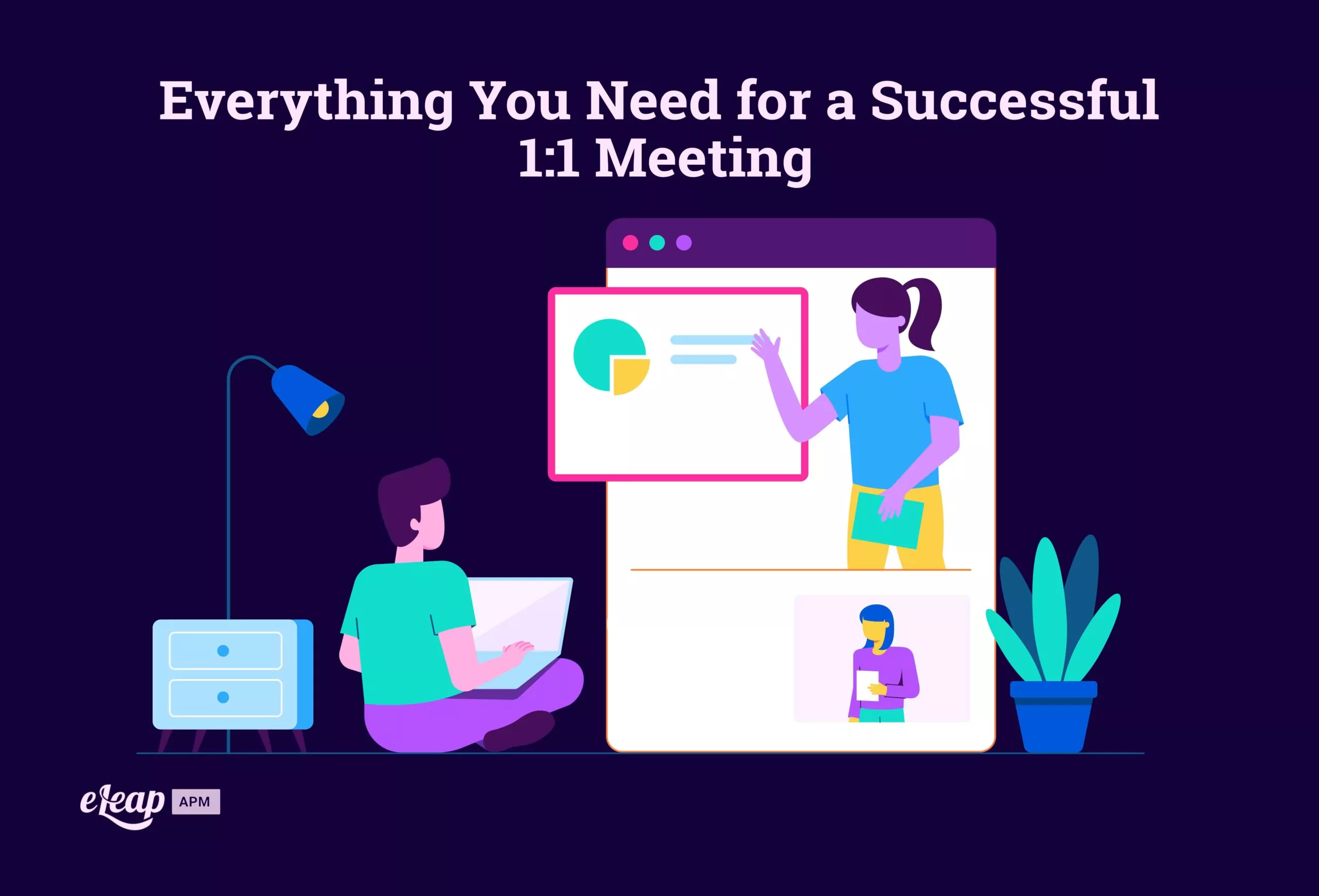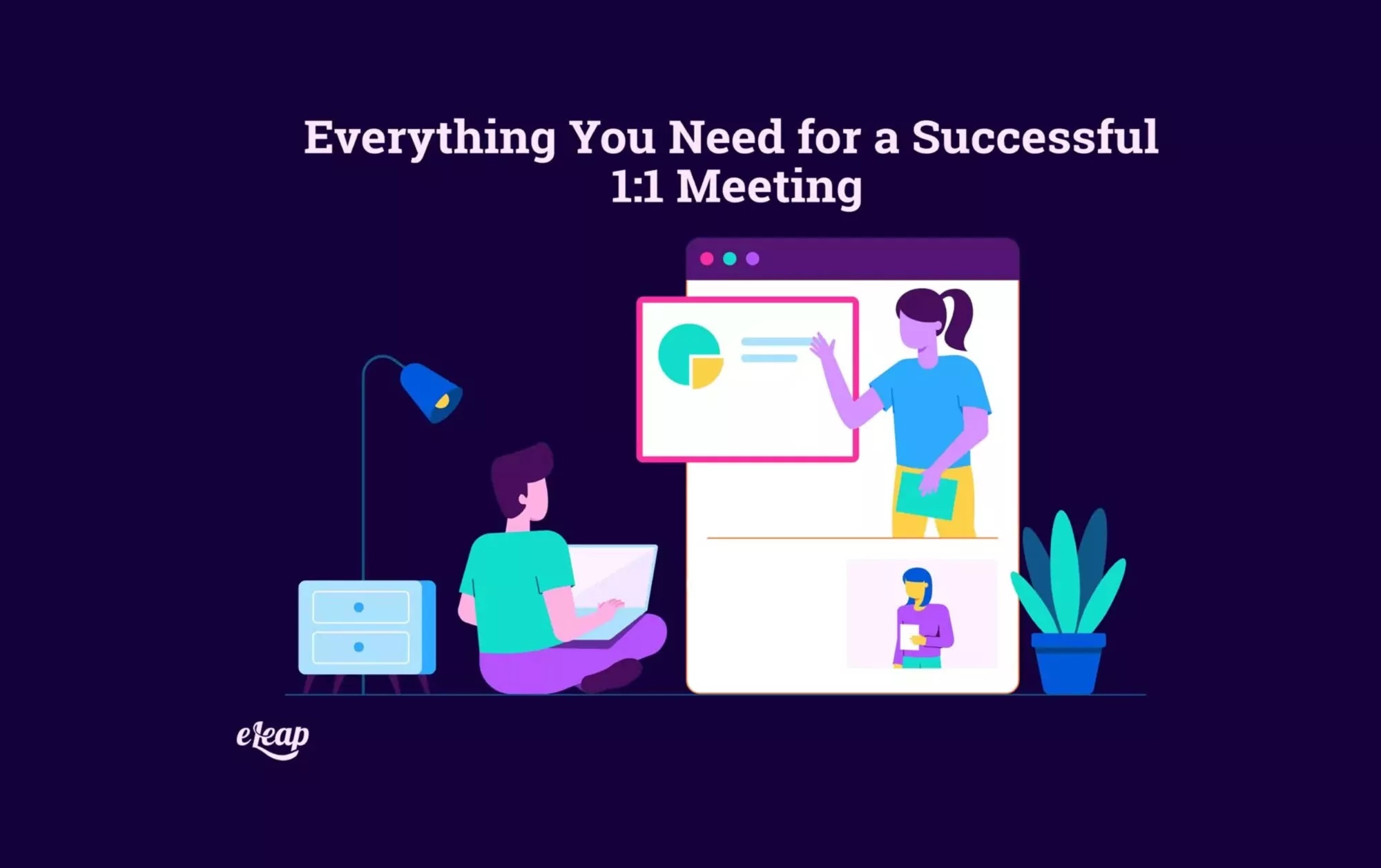Everything You Need for a Successful 1:1 Meeting

Are you scheduled to take part in a 1:1 meeting, but you aren’t sure how to prepare? The idea of meeting one on one can be intimidating, but it’s an essential tool for being able to develop in the workplace! In fact, 1:1 meetings make a huge difference for both managers and employees when they’re done regularly! If done right, these meetings provide psychological safety for employees and their managers to develop stronger relations which ultimately enhance the work environment. See how eLeaP can help with Check-ins and 1-on-1s.
Before you sit down in your meeting, there are some things you need to know! Let’s look at why 1:1 meetings matter and how you can make them effective! You can also schedule a quick session with our solutions experts to see how eLeaP can maximize your 1-on-1s.
The Importance of 1:1 Meetings
Employees who have regular 1:1 meetings with their manager are three times more likely to stay productive and engaged at work. That’s an impressive statistic! There are many other reasons why these meetings are vital to individual success in the workplace!
Some of the great benefits you’ll see with 1:1 meetings include:
- Having the chance for consistent, impactful conversations between employees and their direct managers.
- Allowing a place where both people can provide feedback and look into areas of growth opportunity.
- Boosting both engagement and productivity in the workplace as well as helping build relationships between employees and leadership.
- Helping combat current issues in the workplace and working through solutions for them in real time.

Why You Should Have Regular 1:1 Meetings
Obviously, the benefits of having regular meetings with your employees are great! However, it may seem like too much to take on, meeting with everyone regularly.
1:1 meetings are crucial for developing your employees and are well worth the time invested! In fact, incorporating these meetings regularly can help address issues you’re likely facing in the workplace!
1:1 Meetings Give You an Easy Check-In Opportunity
Having a sit down with one other person gives you the ability to check in and see how you’re both doing on an individual level. When you have a group setting, it’s harder to learn how everyone on the team is doing. For one, there simply isn’t enough time. And for two, many people aren’t comfortable addressing their personal challenges in a group setting.
Having a 1:1 meeting allows you to create a simple check-in opportunity that’s laid back and confidential between the two participants.
Private Discussions
As mentioned before, it’s hard for many people to vocalize their challenges, goals, and ideas in a group setting. When employees aren’t able to do this, it can really hurt their ability to grow and advance in the workplace. Creating a regular 1:1 meeting is a perfect time to be able to discuss those thoughts.
The balanced dynamic allows most workers to feel freer to express their thoughts, good and bad. This allows relationships and trust to grow, which are also crucial in growing at work.
Building Value
When employees receive impactful conversations one on one with their manager, they are more likely to feel valued at work. This can allow employees to build confidence at work and feel more motivated. When employees feel noticed by their manager, it helps them want to work and continue to prove themselves.
A 1:1 meeting is the perfect time to express the value managers see in their employees and the appreciation they feel. When employees feel like a necessary asset to the team, it will improve morale and work culture.
Tips for 1:1 Meetings – Management
Both managers and team members need to prepare for a 1:1 meeting in order to experience the most success. First, let’s look at how managers can best prepare!
Reminders
Whether you’ve done a hundred 1:1 meetings or you’re about to do your first one, there are some reminders that every manager should have in mind while preparing:
- Always keep an open mind.
- Remember to focus on problem-solving as a duo.
- Ask questions – don’t give orders
- Actively listen to what your employee has to say.
- Don’t blame your employees for issues
Topics
If you want to make sure you’re having a successful 1:1 meeting, there are some topics you should look to cover in each one.
Goals
Make sure to take some time and discuss the goals and metrics of each individual you meet with. It’s important to make sure everyone knows what the goals of the team are and how they are meeting the goals as an individual.
This is a perfect time to pull up any data or metrics you have so that your employees can see the proof behind what you’re saying.
Feedback
The feedback portion of your 1:1 meeting should always be two-sided. Take time to give honest and constructive feedback to your employee, focusing on behaviors and not their personality traits.
Then, flip the table and ask for honest feedback from your employee on your performance. Make sure there is clear trust between the two of you and reiterate that they can be honest and vulnerable. Expect to need to ask direct questions at first while the employee builds their confidence. The more meetings you have one on one, the better the feedback is likely to become.
Development
This is the right time to ask your employee what their goals are. Find out what position they desire to reach in the company or what their general career goals are. With this in mind, you can discuss skills they should begin developing or improving on.
With an end goal in mind, it’s easier to create a development plan that is unique and tailored to each employee. This approach is likely to have your employees more eager to work on developing their skills.
Praise
Don’t forget to recognize areas at work where your employee is excelling. Everyone likes receiving praise when they’re doing well. It’s important to let your employees know that you appreciate the work they do and that you’re noticing it!
Tips for 1:1 Meetings – Team Members
While most of the preparation for a 1:1 meeting lies in the manager’s court, there are some things that team members should make sure to do as well. These meetings are a perfect opportunity for candid conversations with your direct manager, so it’s crucial to take advantage of them!
Let’s look at ways to get what you want out of your meeting with your manager.
Set Expectations
If you have specific things you want to discuss in your meeting, be clear about the topics. When possible, let your manager know ahead of time, so they have time to prepare for the topics you want to discuss. Then, make sure you remind your manager at the beginning of your meeting.
A great 1:1 meeting will have time built in for you to have the floor. However, it never hurts to be clear on what you’re expecting right out of the gate to ensure you leave the meeting satisfied.
Manage Up
Managing up is essentially managing your manager. When your manager asks you for your feedback on how they’re doing their job, it’s important to be honest. However, there are professional ways to do so. Remember to only discuss behaviors and don’t attack your manager as a person. Feedback should never focus on a personality trait, whether positive or negative.
When managing up, keep these tips in mind:
- Discover your manager’s leadership style – ask them
- Find out your manager’s preferred communication style
- Give praise by letting your manager know what they’re doing well
Handling Feedback
Feedback is a crucial part of 1:1 meetings. In order to have a successful conversation, you should receive and give feedback during your meeting.
When you ask for feedback, be specific about what you’re asking for. Proactively asking for feedback in an area shows confidence and initiative, which are great behaviors to show your manager. However, don’t just ask general questions like, “how did I do on my last project?” Instead, ask about specific pieces of your project or daily tasks to get feedback.
It’s also a good idea to take notes on the feedback you receive as well as what feedback you give. With these notes, you can look back on the areas that you discussed so that you can refresh your memory as needed.
Be Clear On Next Steps
Make sure that you leave the meeting with a clear understanding of the action steps you should take with the goals discussed. If you don’t set a plan before you leave the meeting, you won’t be able to accurately measure how you’ve performed between meetings.
The best way to have successful 1:1 meetings is by having measurable goals that you can revisit each time you sit down. From there, it’s important to show that you’re making an effort with the feedback you received.
Keep your manager updated on the action steps you’re taking and the improvements you see when you implement the feedback they gave you. Keeping the line of communication open between meetings can help you continue to build trust between the two of you.
Takeaway
While often seen as intimidating, a 1:1 meeting is a great tool to utilize in the workplace. With the right tools and knowledge, both managers and team members can walk into these meetings ready to develop one another and help the overall performance of the team! See how eLeaP can help with Check-ins and 1-on-1s.